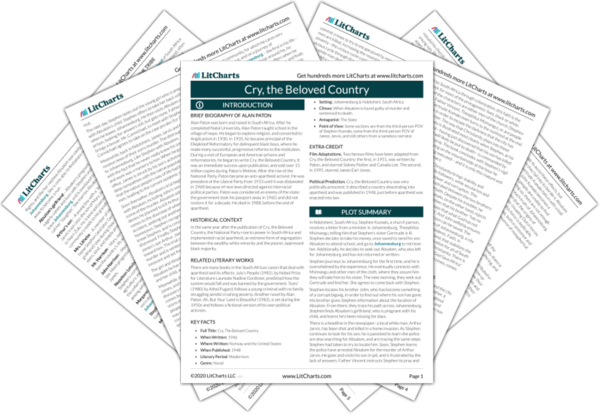Summary
Analysis
On a day when court is not in session, Margaret Jarvis and her niece go into town, leaving James behind at the house. He reads about the gold rush at Odendaalsrust, and how the money and speculation around the gold may prove disastrous in the end, and how there has been some minor black-on-white crime, but nothing horrible.
Just as Stephen read about James’ son’s death in the paper, so James reads about the trouble surrounding the new gold in the newspaper. Both tragedies, reduced to black-and-white words on a page, give information but never really getting at the source of the problem.
Themes
As he is reading, there is a knock on the door. Outside is an elderly black minister—Stephen. James does not recognize Stephen, but Stephen recognizes James, and immediately begins to shake. They greet each other, and then Stephen sits down on the steps, trembling. James tries to offer Stephen some food or drink, but Stephen refuses. Eventually, haltingly, he manages to stand and explain that he is here seeking the daughter of Sibeko, who was hired by the mistress of the house. The servant responds that he has heard of her: she was fired before he began working at the house. James tells Stephen that he can wait for the mistress to return, and she may be able to tell him where she went.
From James's point of view, the reader can see how much of a toll the events of the novel have had on Stephen. Note how, even in his difficult circumstances, Stephen has come seeking another lost lamb, to restore her to the tribe.
Themes
After the servant departs James presses Stephen, insisting that there must be something else between them, based on Stephen's reaction on seeing him. Stephen hesitates, and finally reveals that it was his son, Absalom, who murdered Arthur. James leaves for a moment, walks into the garden for a long moment, and then returns. He assures Stephen that he is not angry with him. He says that he gets it—Stephen had not realized that he, James, would be here at the house. Stephen confirms this, saying that he recognizes him from Ndotsheni.
Because Stephen has found James after James has read so many of Arthur’s writings, and because Stephen is so frail and obviously broken by the tragedy, James is able to tell Stephen that he is not angry with him—in a way, telling him that he does not blame him, because he knows where the true blame lies.
Themes
The mistress returns. James explains to her that Stephen is looking for the daughter of Sibeko. The mistress says that she had indeed come to Johannesburg and lived there, but she had gone bad and started doing illegal things, and was in jail, and had to be dismissed. James translates all of this for Stephen. When James asks her if she knows where the woman has gone, the mistress says that she doesn’t know, and doesn’t care. James only translates the first part of this for Stephen, not wanting him to know that she doesn’t care. When she leaves, James follows Stephen out the back gate and says goodbye.
Like Absalom, Sibeko’s daughter is someone who Stephen will not draw back into the tribe, and is lost forever. James's effort to protect Stephen from the cruel words of the mistress indicate further his newfound compassion for the blacks of South Africa
Themes
Get the entire Cry, the Beloved Country LitChart as a printable PDF.













